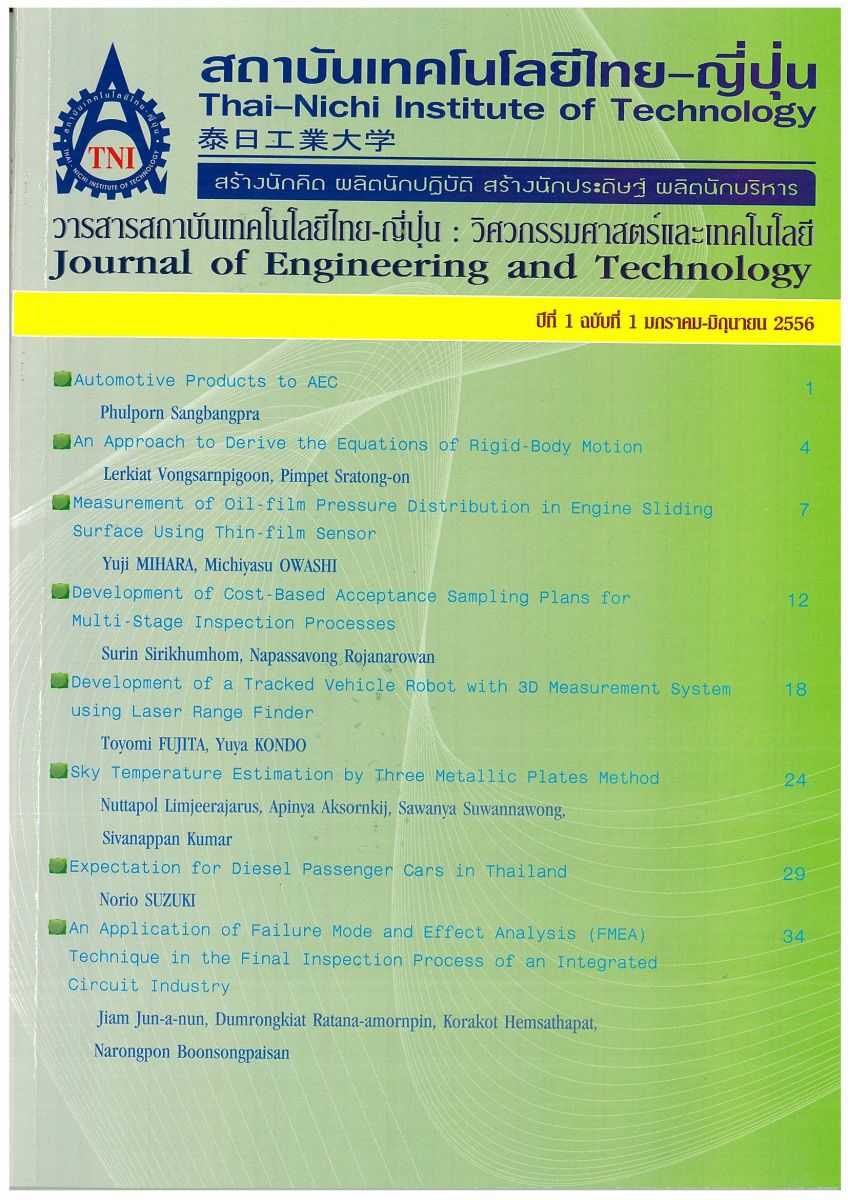A Study of Idle Speed Control Performance Benchmarking of 1,000 cc. - 1,500 cc. Engine
Main Article Content
Abstract
The main objective of this study is to conduct a performance benchmarking of idle speed control system in small automotive engines between 1,000 to 1,500 cc in Thailand. The outcome will be used as a guideline to develop the idle speed control system of the Sample Engine. The performance benchmarking examined 3 different types of engine management system namely; D-Jetronic, L-Jetronic, and the D-Jetronic incorporate with L-Jetronic. The experiment was divided into 16 test conditions which affect the performance of the idle speed control system. Performance indicators were the average of engine speed (N), standard deviation of engine speed (), error value of engine speed from the target speed (
), overshoot, undershoot and track time. The result indicated that Engine “J” with Djetronic engine management system was obtained the highest score and was used to improve the Sample Engine. There are 3 main findings to improve and further develop the Sample Engine. 1) Rapid response of the air intake compensation during the load changes has significant impact on the idle speed control performance. The responsiveness can be improved by, for example, designing the location of the air sensor to be closer to the engine. 2) To return to the target idle speed after high engine speed, instantaneous air intake compensation showed shorter track time than stepping air intake compensation. 3) Size of both battery and alternator has significant impact on the idle speed control performance. The result indicated that automobile sample with a smaller battery and a larger alternator has better performance. This is due to less voltage fluctuation during the idle speed since charging time from the alternator to the battery and the duration of power drawn from the engine to generate electricity was shorter. Thus, the key findings from the study could be used to improve and further develop the Sample Engine in the future.
Article Details
Article Accepting Policy
The editorial board of Thai-Nichi Institute of Technology is pleased to receive articles from lecturers and experts in the fields of engineering and technology written in Thai or English. The academic work submitted for publication must not be published in any other publication before and must not be under consideration of other journal submissions. Therefore, those interested in participating in the dissemination of work and knowledge can submit their article to the editorial board for further submission to the screening committee to consider publishing in the journal. The articles that can be published include solely research articles. Interested persons can prepare their articles by reviewing recommendations for article authors.
Copyright infringement is solely the responsibility of the author(s) of the article. Articles that have been published must be screened and reviewed for quality from qualified experts approved by the editorial board.
The text that appears within each article published in this research journal is a personal opinion of each author, nothing related to Thai-Nichi Institute of Technology, and other faculty members in the institution in any way. Responsibilities and accuracy for the content of each article are owned by each author. If there is any mistake, each author will be responsible for his/her own article(s).
The editorial board reserves the right not to bring any content, views or comments of articles in the Journal of Thai-Nichi Institute of Technology to publish before receiving permission from the authorized author(s) in writing. The published work is the copyright of the Journal of Thai-Nichi Institute of Technology.
References
D. Hrovat; and Jing Sun. Models and control methodologies for IC engine idle speed control design. ControlEngineering Practice, Vol. 5, no. 8, pp. 1093-1100, 1997.
Andrea Balluchi; Luca Benvenuti; Claudio Lemma; Pierpaolo Murrieri; and Alberto L. Sangiovanni-Vincentelli. Idle-speed control: a Benchmark Problem in Automotive Applications. Internal Technical Report. 1-16, 2004.
Teruji Sekozawa. Model-based Control and Learning Control Method for Automobile Idle Speed Control using Electric Throttle. WSEAS Transaction On Systems and Control. Issue 2, Vol. 3:125-136, 2008.
Min Han; Robert N. K. Loh; and Lin Wang. Optimal Idle Speed Control of an Automotive Engine. Electronic Engine Controls : Sensors, Actuators, and Development Tools. Society of Automotive Engineers, USA, 1998.
American Productivity & Quality Center. The Benchmarking Management Guide. Portland: Productivity Press, 1993.
พอล เจมส์ โรแบร์. 2543. หลักการวิเคราะห์และเปรียบเทียบความสามารถอย่างเป็นระบบ. พิมพ์ครั้งที่ 1/2543. กรุงเทพมหานคร : มหาวิทยาลัยธุรกิจบัณฑิตย์.
M. Thornhill; S. Thomson; and H. Sindano. A comparison of idle speed control schemes. Control Engineering Practice, 8, 519-530, 2000.


